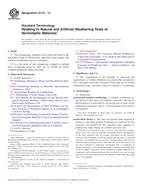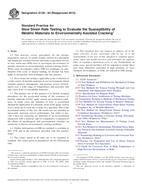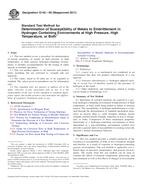Potřebujeme váš souhlas k využití jednotlivých dat, aby se vám mimo jiné mohly ukazovat informace týkající se vašich zájmů. Souhlas udělíte kliknutím na tlačítko „OK“.
ASTM E45-13
Standard Test Methods for Determining the Inclusion Content of Steel
Automaticky přeložený název:
Standardní zkušební metody pro stanovení zahrnutí Obsah oceli
NORMA vydána dne 1.5.2013
Informace o normě:
Označení normy: ASTM E45-13
Poznámka: NEPLATNÁ
Datum vydání normy: 1.5.2013
Kód zboží: NS-46828
Počet stran: 19
Přibližná hmotnost: 57 g (0.13 liber)
Země: Americká technická norma
Kategorie: Technické normy ASTM
Kategorie - podobné normy:
Anotace textu normy ASTM E45-13 :
Keywords:
alumina, automatic image analysis, complex inclusions, fracture test, globular inclusions, inclusions, inclusion rating, inclusion stringers, JK inclusion rating, light microscopy, macroetch test, magnetic-particle method, oxide, SAM rating, silicate, steel, step-down method, stringer, sulfide, ICS Number Code 77.040.99 (Other methods of testing metals)
Doplňující informace
| Significance and Use | ||||||||||||||||||
|
4.1 These test methods cover four macroscopic and five microscopic test methods (manual and image analysis) for describing the inclusion content of steel and procedures for expressing test results. 4.2 Inclusions are characterized by size, shape, concentration, and distribution rather than chemical composition. Although compositions are not identified, Microscopic methods place inclusions into one of several composition-related categories (sulfides, oxides, and silicates—the last as a type of oxide). Paragraph 4.3 The macroscopic test methods evaluate larger surface areas than microscopic test methods and because examination is visual or at low magnifications, these methods are best suited for detecting larger inclusions. Macroscopic methods are not suitable for detecting inclusions smaller than about 0.40 mm (1/64 in.) in length and the methods do not discriminate inclusions by type. 4.4 The microscopic test methods are employed to characterize inclusions that form as a result of deoxidation or due to limited solubility in solid steel (indigenous inclusions). As stated in 1.1, these microscopic test methods rate inclusion severities and types based on morphological type, that is, by size, shape, concentration, and distribution, but not specifically by composition. These inclusions are characterized by morphological type, that is, by size, shape, concentration, and distribution, but not specifically by composition. The microscopic methods are not intended for assessing the content of exogenous inclusions (those from entrapped slag or refractories). In case of a dispute whether an inclusion is indigenous or exogenous, microanalytical techniques such as energy dispersive X-ray spectroscopy (EDS) may be used to aid in determining the nature of the inclusion. However, experience and knowledge of the casting process and production materials, such as deoxidation, desulfurization, and inclusion shape control additives as well as refractory and furnace liner compositions must be employed with the microanalytical results to determine if an inclusion is indigenous or exogenous 4.5 Because the inclusion population within a given lot of steel varies with position, the lot must be statistically sampled in order to assess its inclusion content. The degree of sampling must be adequate for the lot size and its specific characteristics. Materials with very low inclusion contents may be more accurately rated by automatic image analysis, which permits more precise microscopic ratings. 4.6 Results of macroscopic and microscopic test methods may be used to qualify material for shipment, but these test methods do not provide guidelines for acceptance or rejection purposes. Qualification criteria for assessing the data developed by these methods can be found in ASTM product standards or may be described by purchaser-producer agreements. By agreements between producer and purchaser, these test methods may be modified to count only certain inclusion types and thicknesses, or only those inclusions above a certain severity level, or both. Also, by agreement, qualitative practices may be used where only the highest severity ratings for each inclusion type and thickness are defined or the number of fields containing these highest severity ratings are tabulated. 4.7 These test methods are intended for use on wrought metallic structures. While a minimum level of deformation is not specified, the test methods are not suitable for use on cast structures or on lightly worked structures. 4.8 Guidelines are provided to rate inclusions in steels treated with rare earth additions or calcium-bearing compounds. When such steels are evaluated, the test report should describe the nature of the inclusions rated according to each inclusion category (A, B, C, D). 4.9 In addition to the Test Methods E45 JK ratings, basic (such as used in Practice E1245) stereological measurements (for example, the volume fraction of sulfides and oxides, the number of sulfides or oxides per square millimeter, the spacing between inclusions, and so forth) may be separately determined and added to the test report, if desired for additional information. This practice, however, does not address the measurement of such parameters. |
||||||||||||||||||
| 1. Scope | ||||||||||||||||||
|
1.1 These test methods cover a number of recognized procedures for determining the nonmetallic inclusion content of wrought steel. Macroscopic methods include macroetch, fracture, step-down, and magnetic particle tests. Microscopic methods include five generally accepted systems of examination. In these microscopic methods, inclusions are assigned to a category based on similarities in morphology, and not necessarily on their chemical identity. Metallographic techniques that allow simple differentiation between morphologically similar inclusions are briefly discussed. While the methods are primarily intended for rating inclusions, constituents such as carbides, nitrides, carbonitrides, borides, and intermetallic phases may be rated using some of the microscopic methods. In some cases, alloys other than steels may be rated using one or more of these methods; the methods will be described in terms of their use on steels. 1.2 These test methods cover procedures to perform JK-type inclusion ratings using automatic image analysis in accordance with microscopic methods A and D. 1.3 Depending on the type of steel and the properties required, either a macroscopic or a microscopic method for determining the inclusion content, or combinations of the two methods, may be found most satisfactory. 1.4 These test methods deal only with recommended test methods and nothing in them should be construed as defining or establishing limits of acceptability for any grade of steel. 1.5 The values stated in SI units are to be regarded as the standard. Values in parentheses are conversions and are approximate. 1.6 This standard does not purport to address all of the safety concerns, if any, associated with its use. It is the responsibility of the user of this standard to establish appropriate safety and health practices and determine the applicability of regulatory limitations prior to use. |
||||||||||||||||||
| 2. Referenced Documents | ||||||||||||||||||
|
Podobné normy:
Historická
1.6.2012
Historická
15.6.2008
Historická
15.6.2008
Historická
1.3.2014
Historická
1.5.2013
Historická
1.3.2011
Doporučujeme:
Aktualizace technických norem
Chcete mít jistotu, že používáte pouze platné technické normy?
Nabízíme Vám řešení, které Vám zajistí měsíční přehled o aktuálnosti norem, které používáte.
Chcete vědět více informací? Podívejte se na tuto stránku.



 ASTM F1459-06(2012)..
ASTM F1459-06(2012).. ASTM F1593-08
ASTM F1593-08 ASTM F1710-08
ASTM F1710-08 ASTM G113-14
ASTM G113-14 ASTM G129-00(2013)..
ASTM G129-00(2013).. ASTM G142-98(2011)..
ASTM G142-98(2011)..
 Cookies
Cookies
